Do Underground Aquarium Filders Need Additional Filter
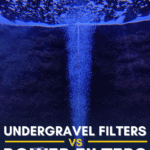
For all the advancements made in fish tank filter systems over the last couple of decades, I'k surprised at how fiddling undergravel filters have changed. They were once the but selection for pocket-size tanks, but modernistic power systems offering better filtration at a similar toll. What are the ramifications of using undergravel filters vs power filters?
Undergravel Filter VS Power Filter in Aquarium

Mostly Biological Filtration
Installed at the time of set-upward and prior to calculation substrate
Inexpensive
Like shooting fish in a barrel to operate
Ideal for 30-gallon and underplanted/aquascaped aquariums with few fish
Non ideal for debris removal or water purification
Limits substrate options
Simply fit in some standard-sized tanks
Harder to install and maintain
Not ideal for tanks with moderate-to-high numbers of fish
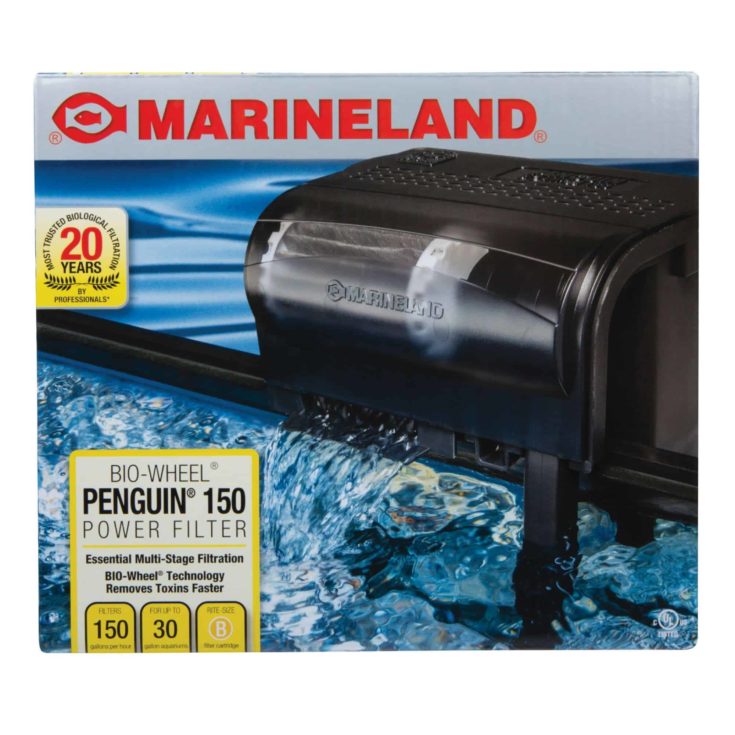
Robust Mechanical and Chemical filtration
Easy to install on the back or side of new and existing tanks
Comes in a diversity of sizes and toll points
Fits on or in most styles of aquarium, including custom tanks
Media mix is customizable
Easy to admission and relocate if needed
Comes in upkeep and premium models
Platonic for planted and fish-but customs tanks 2.v gallons and up
Slightly more than expensive to buy and maintain
Biological filtration is limited
More complicated to operate
What's The Departure Between Undergravel Filters vs Power Filters?
Undergravel filters are cheap air-pump-driven devices that primarily offer biological filtration via the good bacteria in your substrate. Power filters have electrical motors and are more robust and efficient. They offer customizable mixes of mechanical and chemic filtration media, and some take biological stages too.
Power filters are virtually e'er superior to undergravel systems in their filtering abilities. Undergravels don't do a great job at removing debris (mechanical filtration) or purifying the water (chemical filtration), and their chief benefit is to draw debris into the substrate where they break downwardly biologically.
What is an Undergravel Filter?
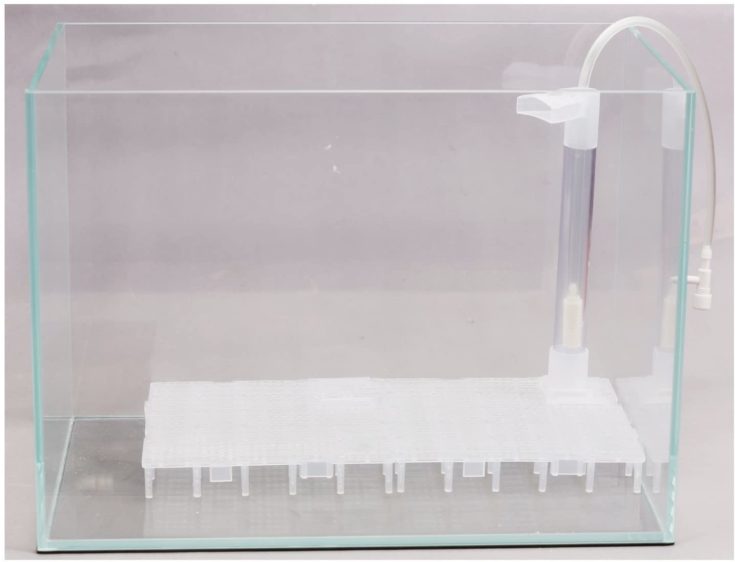
Undergravel systems work by using your substrate equally their principal filter media. They typically include: plastic screens, plastic lift tubes and some pre-filled replaceable media cartridges. To assemble, adhere the lift tubes to the screen and prune the cartridges to the end of the lift tubes.
To set-upwards an undergravel filter in your fish tank, you'll demand an empty aquarium, thin plastic aquarium tubing, and an appropriate air pump:
- Identify the screen and lift tubes in the bottom of the empty tank.
- Encompass the screen with a couple of inches of coarse gravel.
- Use plastic tubing to connect the filter to your air pump.
- Make full the tank with dechlorinated water.
- Plug the air pump in and the filter should start bubbling.
How Do Undergravel Filtration Systems Work?
Undergravel filters mainly provide biological filtration from the adept bacteria in your substrate, which turn droppings into constitute food as part of the Nitrogen Cycle in your tank:
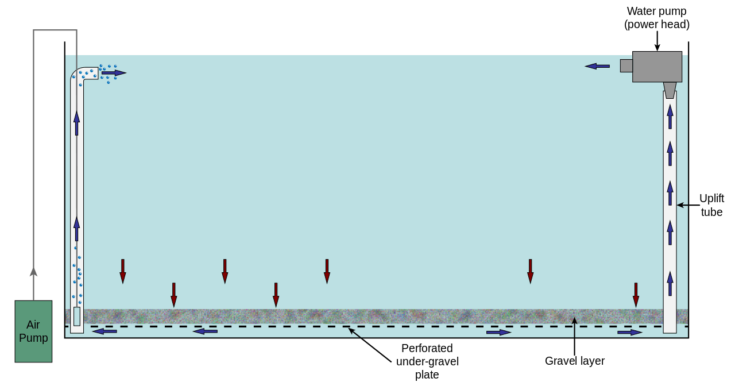
- The air pump generates suction, which pulls dirty water through the substrate and screen to the very lesser of your tank.
- The h2o goes upward the elevator tube and through the media cartridge, where it mixes with air and bubbles back into your tank.
- Large debris get trapped in the substrate and are eventually consumed by bacteria.
- Finer particles collect under the screen and form a matrix of biofilm, but some also catamenia up the elevator tube and may be trapped in the cartridge.
Should I Utilise an Undergravel Filtration Arrangement: Pros and Cons
These filters are cheap and available in a range of sizes that fit standard-sized tanks from ten to 55-gallons. They work well for modest planted tanks, since debris decaying in and under the substrate provides nutrients your plants can apply. They likewise act similarly to air stones and oxygenate your aquarium water.
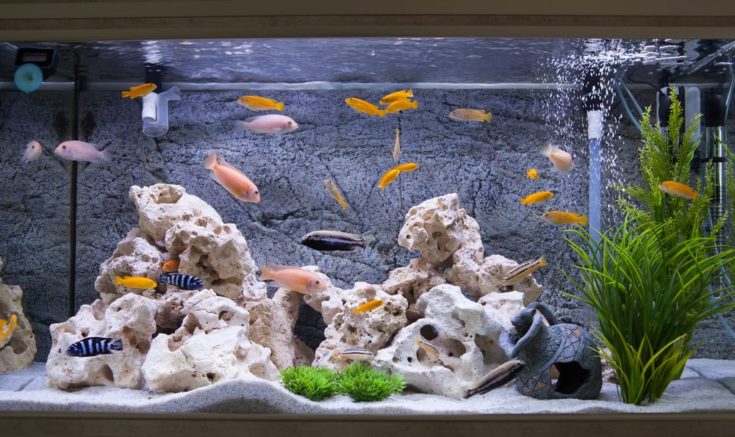
But they are less-than-ideal every bit a stand up-lone filter for most tanks and especially those with moderate to high populations of fish:
- While undergravels can provide some mechanical and chemical filtration via the cartridges, it's very limited, since they can't hold much media.
- The screens limit the type of substrate y'all can apply; fine sands and soils would fall through the gaps in the screen.
- You tin can't bury the screens too deeply or the air pump and filter won't work.
- It can take a few months for bacteria to become established in a new tank, so your filter may not be very effective initially.
- The filter isn't adjustable once it's in identify, and yous'll have to intermission your tank downwardly one time a twelvemonth to clean the biofilm sludge from nether the filter's screen.
What Are Power Filters?
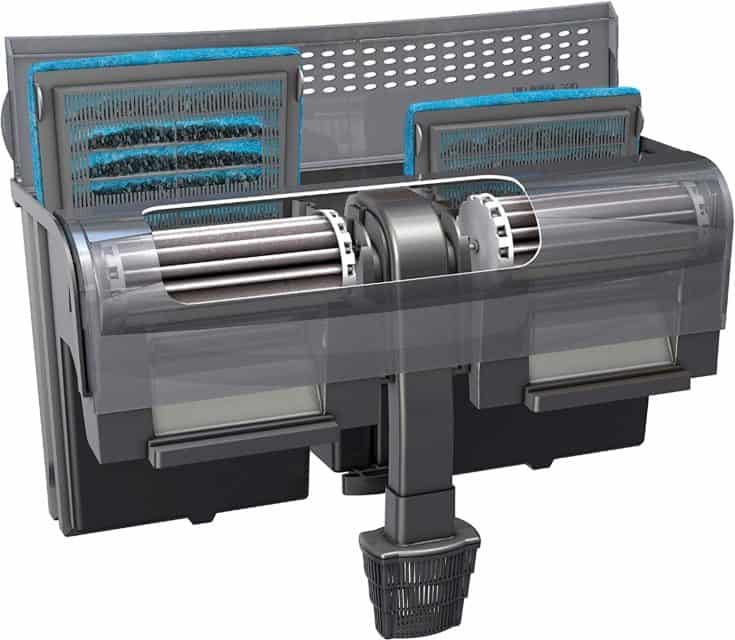
Power systems hang on or inside your tank and employ electrical motors to push water through the filtration stages inside the main compartment. They collect and remove debris and purify water using filter media, and some also offer biological filtration. They are ideal stand-solitary filters for tanks from 2.5 gallons to 55-gallons.
These filters are ready-to-get right out of the box and come with everything you need to install and use them:
- Unbox the filter and bank check that the motor and impeller are in place and the compartment is articulate of droppings.
- Rinse your filter media in tap water.
- Slide the cartridges, sponges or media baskets into place inside the compartment.
- Hang your filter on the dorsum of the tank or identify information technology deeply inside.
- Prime the impeller with water (if needed) and plug the filter in, and it should start correct upwards.
Types of Ability Filtration
There are two primary types of power filtration systems. For nano tanks and small fish bowls, yous can utilise a small internal power system that sits or hangs within the aquarium. For larger set-ups, the robust and classic Hang-on-Back or HOB filter is 1 of the best power options.
How Exercise Ability Filtration Systems Work?
HOB filters are more powerful than the smaller internal options, since they pump h2o out of your tank confronting gravity, but both styles work in similar fashions. The motor turns the impeller, which pulls water up the intake tube and sends it through the filtration stages. Clean water flows back into the tank via the outflow vent.
Large droppings are defenseless by the filter pads within the beginning phase, while pieces of carbon, ammonia fries, or bio-media in the other stages blot or intermission-downwards toxins. Water polishing sponges may remove microscopic debris besides, leaving your water sparkling clear and smelling fresh.
Should I Apply a Ability Filtration System: Pros and Cons
Power systems are much more than effective at removing debris and toxins from your water than the undergravel options, and they are a lot easier to maintain:
- They'll reduce the frequency of your h2o changes and lower the amount of maintenance you lot have to perform.
- They are adjustable and can be removed easily for cleaning or relocation.
- The media in HOB-style filters remain accessible while the filter is operating and you won't even take to reach into the water to change them.
- They tin be used in planted tanks and for highly-stocked fish communities.
- Media mix used inside is customizable to the needs of your specific set-up.
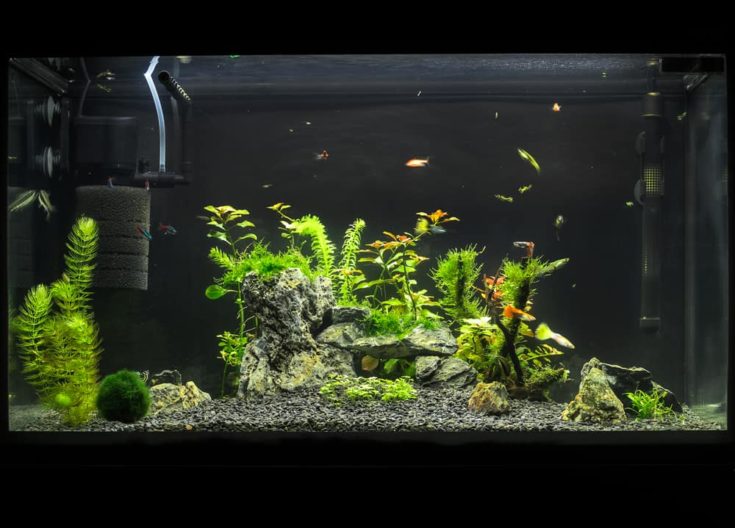
The main disadvantage of power systems compared to undergravels is that they don't provide as much biological filtration, and they may non circulate h2o to every corner of your tank. Big aquariums unremarkably require more than one filtration system.
Which is Improve: Undergravel or Power Filtration System?
Now that y'all know how they work, let's consider the implications of installing these filters and compare how they perform in your tank.
Filtering Capabilities
Power systems are better at collecting and removing droppings from your tank, and offer more water purification than an undergravel system. Premium models may besides have built-in bio-stages, like wheels or outflow sponges, and all types allow customizable mixes of media. Undergravel systems are ideal for feeding plants, merely less useful for removing large debris or purifying water.
Set-Upwards and Ease-of-Use
Undergravel filters are easy to use, and there'south not much to fuss with other than irresolute the cartridges. They're harder to install, because you lot can't add one to an established tank without breaking it downward to a bare bottom. In one case they're in place, you lot can't hands make adjustments, and yous'll accept to aquascape around the lift tubes.
Ability filters are easy to set-upwardly and relocate on demand, and you'll accept a lot of options when it comes to location and the filter media. One time in place, however, a power filter requires more than attention. Since they usually hang exterior your tank, there'south e'er the possibility they could spring a leak.
Maintenance
Undergravel systems are easy to maintain monthly but they are a animal when it comes to yearly cleaning. They end working if y'all don't clean out the build-upward of biofilm under the screen. They likewise won't spare you any of your weekly h2o changes. Large debris like fish poop and dead leaves collect on superlative of the substrate and need to be vacuumed out.
From a maintenance standpoint, even the weaker internal filters are superior to the undergravels considering you can always remove them for cleaning. While it'southward a good idea to check your HOB daily to look for leaks or chock-full media, they are much easier to maintain long term than undergravels.
Toll

While undergravel systems are prized for their cheapness, the truth is that you can become a modern ability filter for most the same price one time yous cistron in the air pump.
If y'all're on a tight budget, y'all may be better off with a ability filter, since information technology will protect your fish and tank better in the long term.
Using Undergravel and Power Filters Together
If you install an undergravel system and find it's not enough to continue your tank clean, you lot can always add together some other filter to pick upward the slack. In fact, combining an undergravel with a ability system is a great style to get superb filtration in a large customs tank! You'd have mechanical, chemical and biological filtration covered!
Conclusion
These days, information technology makes a lot more sense to invest in a ability system rather than an undergravel if yous're looking for a stand-alone filter. They are similar in cost, but a HOB or internal filter volition provide much more than filtration bang for your buck.
Frankly, most folks who outset with undergravels get sick of having to vacuum debris out every calendar week, and so save yourself the labor and get a power filter. You could too use them together in a planted or aquascaped aquarium.
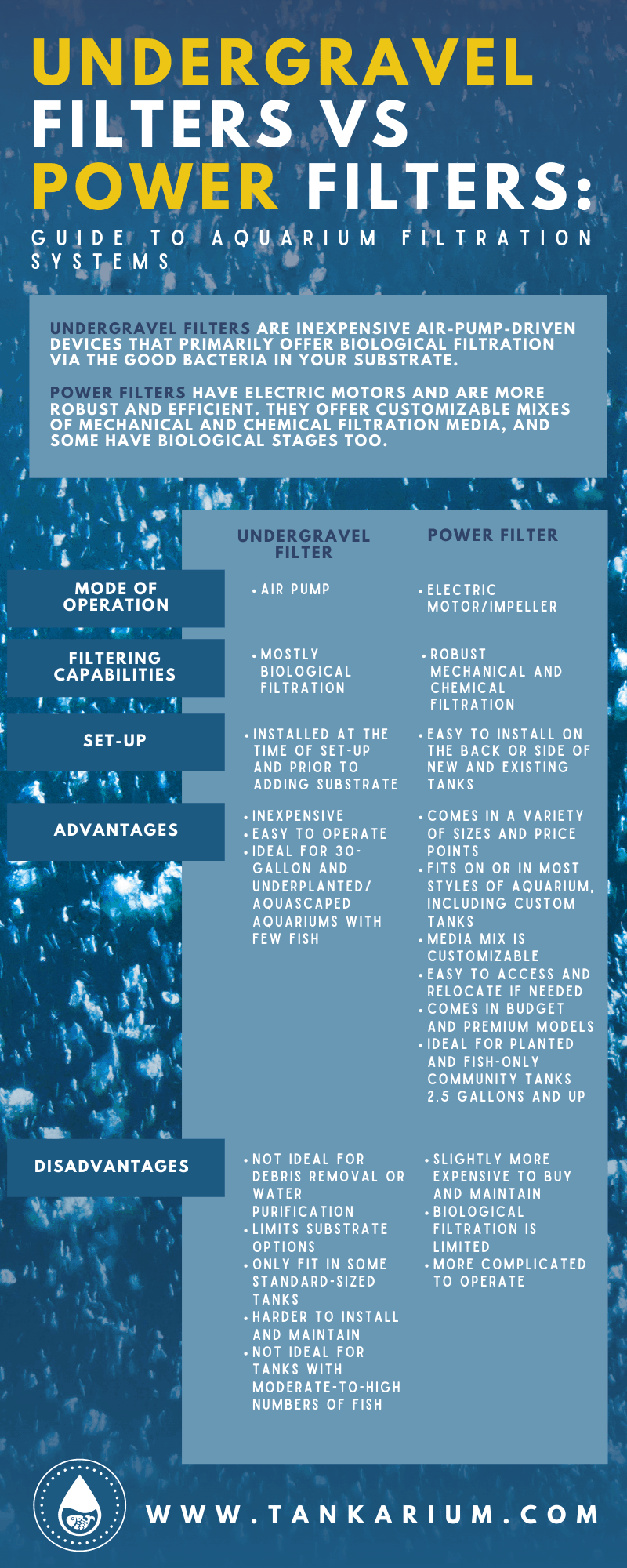
Do Underground Aquarium Filders Need Additional Filter,
Source: https://www.tankarium.com/undergravel-filter-vs-power-filter/
Posted by: hiserwarge1965.blogspot.com


0 Response to "Do Underground Aquarium Filders Need Additional Filter"
Post a Comment